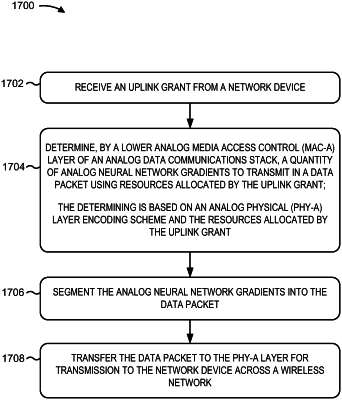| CPC H04W 72/23 (2023.01) [H04L 1/0071 (2013.01); H04L 5/0051 (2013.01); H04W 52/365 (2013.01); H04W 80/02 (2013.01)] | 30 Claims |

|
1. A method of wireless communication by a user equipment (UE), comprising:
receiving an uplink grant from a network device;
determining, by a lower analog media access control (MAC-A) layer of an analog data communications stack, a quantity of analog neural network gradients to transmit in a data packet using resources allocated by the uplink grant, the determining based on an analog physical (PHY-A) layer encoding scheme and the resources allocated by the uplink grant;
segmenting the analog neural network gradients into the data packet; and
transferring the data packet to the PHY-A layer for transmission to the network device across a wireless network.
|